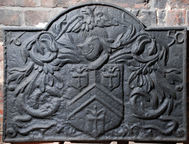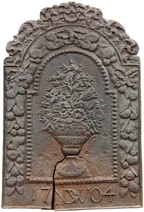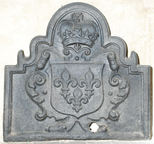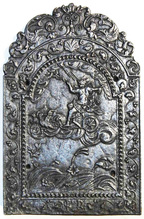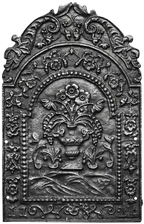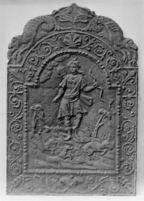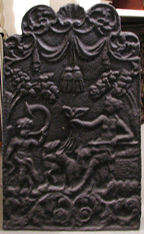-
817
Description: Arched rectangular shape; fillet edging; shield, helm, crest and mantling of the Worshipful Company of Blacksmiths (see Fig. 3); date in top corners; initials at bottom, below mantling; two planklines.
Notes: One of the hooked ‘1’ series; a copy from an evenly impressed original.
Copies of this fireback are known.
Inscription: 16 50 / I M
Arms: Worshipful Company of Blacksmiths
- Decoration tags:
- rectangular with round arch (shape)
- fillet (edging)
- whole carved pattern
- planklines
- armorial
- text
Manufactured: in 1650 possibly at Brede Furnace in the Weald area of England.
Current location: in private hands, Mayfield, East Sussex, England.
- Attached to series:
- Hooked '1' series
- Livery company firebacks
- Brede group
- IM series
-
1275
Description: Arched rectangular central panel with bead-on-fillet edging; central vase containg a variety of flowers and foliage; arched rectangular border with fillet edging containing two arrangements of fruit and leaves descending on each side from ribbons, and with ribbons at the shoulders; at the bottom, the monogram 'NDW' between the two halves of the date; above the arch, descending scrolled foliage.
Notes: This fireback differs in its form from others with the NDW monogram and is closer to an English form seen in the TAN series, albeit considerably smaller.
Inscription: 17 NDW 04
- Decoration tags:
- 'Dutch' (shape)
- fillet (edging)
- whole carved pattern
- individual numbers
- pictorial
- monogram
- text
- plants
- objects
Manufactured: in 1704 possibly in the Siegerland area of Germany.
Current location: not known.
- Attached to series:
- 'Dutch' NDW series
-
488
Description: Rectangular with complex quasi-arched rectangular top; fillet edging; shield with Royal arms of France in a cartouche; above, an English crown.
Notes: The combination of the English crown and French arms is common and may relate to the marriage of Charles I and Princess Henrietta Maria of France in 1625. A different version is no. 659. Said to have been cast by Thomas Prickett (1727-95) at Gloucester Furnace, Lamberhurst. Formerly part of the J. H. Every collection.
Copies of this fireback are known.
Arms: France modern
- Decoration tags:
- rectangular with round arch (shape)
- fillet (edging)
- whole carved pattern
- armorial
- royal
Manufactured: in the early- to mid-17th century probably at Gloucester Furnace, Lamberhurst in the Weald area of England.
Current location: Michelham Priory, Arlington, East Sussex, England.
Museum number: 1944.24.068 (part of the Sussex Archaeological Society museum group)
Citation: Dawson, C., 1903, 'Sussex Iron Work and Pottery', Sussex Archaeological Collections, 46, pp. 1-54.
- Attached to series:
- Ornate border series
- Miscellaneous royal firebacks
- Anglo-French armorial firebacks
-
1131
Description: Arched rectangular shaped central panel with 'nutshell' edging; pictorial: Mercury in his chariot drawn by two birds (possibly ravens) across the clouds, his caduceus held aloft; above are clouds, below is a landscape with plants; arched rectangular shaped border with fillet edging, a scallop shell top centre with descending symmetrical arrangement of vine and acanthus leaves and tendrils; the monogram, SHR, bottom centre; on top is a symmetrical design of scrolled floral tendrils. One vertical plankline right of centre.
Notes: The design is based on a personification of the planet Mercury in 'Planetarum effectus et eorum in signis zodiaci', by Marten de Vos (1585). Two editions of engravings of de Vos's drawings are known, by Jan Sadeler, dated 1585, and by Gregor Fentzel in about 1650. The holes were for fixing to a grate.
Inscription: SHR
- Decoration tags:
- 'Dutch' (shape)
- fillet (edging)
- whole carved pattern
- planklines
- pictorial
- allegorical
- monogram
- animals
- humans
- plants
Manufactured: in the late-17th to early-18th century in England.
Current location: not known.
- Attached to series:
- SHR series
- British 'Dutch' style firebacks
- De Vos Planets series
-
1296
Description: Low arched rectangular shape; broad rebated fillet edging; stylised Tudor royal shield, crown and supporters (dragon and greyhound); Tudor rose in top left corner; portcullis in top right corner.
Notes: Pastiche 'Tudor' design by George Shaw of Saddleworth, Lancashire, c.1850, possibly intended to be passed off as genuine Tudor. Another casting is at Hever Castle, Kent. Firebacks with the same armorial design within a different, arched edging are also known.
Copies of this fireback are known.
Arms: Tudor royal
- Decoration tags:
- rectangular with round arch (shape)
- fillet (edging)
- carved pattern panels
- heraldic
- armorial
- royal
Manufactured: in the mid-19th century possibly in the Lancashire area of England.
Current location: Mottistone Manor, Brighstone, Isle of Wight, England.
Museum number: NT/MOE/M/2 (part of the National Trust museum group)
- Attached to series:
- George Shaw series
- Tudor royal armorial firebacks
-
1290
Description: Rectangular, with arch at the top. Above and below acanthus vines. In the middle a landscape with trees and two seated figures; on the left Mercury, playing a flute, a staff over his right shoulder, and at his feet a caduceus; to the right a seated male figure with his left hand supporting his head, in his right hand a stick with which he is supporting himself, behind him a cow, at his feet a dog.
Notes: A scene from classical mythology.
- Decoration tags:
- rectangular with ornate arch (shape)
- fillet (edging)
- whole carved pattern
- pictorial
- mythological
- animals
- humans
- plants
- objects
Manufactured: in the early-18th century in England.
Current location: Rotterdam, Netherlands.
Museum number: 15229 (part of the Museum Rotterdam museum group)
- Attached to series:
- Late pictorial series 2
- Late pictorial series (all)
-
53
Description: Arched rectangular shaped central panel, bead on fillet edging, narrow-necked urn with flowers issuing therefrom; arched rectangular shaped border with fillet edging and symmetrical floral swags; on top, stylised fish with floral accessories; at bottom, two looped 'W' figures between split date in bottom corners. A faint plankline, slightly inclined from the vertical and more evident on a later casting, can be seen slightly left of centre.
Notes: The second smallest of six flower vase designs in this series. All incorporate the looped 'W' motif which may be intended to identify the pattern maker. A clear vertical plankline left of centre.
Copies of this fireback are known.
Inscription: 17 24
- Decoration tags:
- 'Dutch' (shape)
- fillet (edging)
- whole carved pattern
- planklines
- pictorial
- text
- plants
- objects
Manufactured: in 1724 in England.
Current location: Thornhill Galleries, 43-45 Wellington Crescent, New Malden, Surrey, England.
- Attached to series:
- 1724 series
- British 'Dutch' style firebacks
-
866
Description: Rectangular with a sinuous arch and three simulated loops, one top centre, the other two to each side; two-handled flower vase with gadrooned upper surface and acanthus bas-relief below, trailing fruited vines issuing from top descending through handles to base; lion’s mask at top; date split either side of vase base; ball on each shoulder of the plate; broadened side edges.
Notes: The simulated loops are seen on a small number of other firebacks, suggesting a common pattern-maker; a variation on a design typical of this period.
Inscription: 16 77
- Decoration tags:
- rectangular with ornate arch (shape)
- fillet (edging)
- whole carved pattern
- individual numbers
- extension panels
- pictorial
- text
- plants
- objects
Manufactured: in 1677 possibly in the Weald area of England.
Current location: Metropolitan Museum of Art, 1000, Fifth Avenue, New York, New York, United States of America.
Museum number: 08.81.1 (part of the Metropolitan Museum of Art, New York museum group)
- Attached to series:
- Gadrooned vase firebacks
- Loop edged firebacks
-
867
Description: Arched rectangular central panel; bead-and-pellet edging; pictorial scene of a male figure, standing on a ground with trees and animals, with a quiver of arrows and holding a bow in his left hand; clouds above; arched rectangular border with fillet edging; repeated, linked scroll-work on all sides; on top symmetrical leaves between two mirrored serpents.
Notes: The figure is probably that of Apollo.
- Decoration tags:
- 'Dutch' (shape)
- fillet (edging)
- whole carved pattern
- mythological
- animals
- humans
- plants
Manufactured: in the early-18th century in England.
Current location: Metropolitan Museum of Art, 1000, Fifth Avenue, New York, New York, United States of America.
Museum number: 08.81.2 (part of the Metropolitan Museum of Art, New York museum group)
- Attached to series:
- British 'Dutch' style firebacks
-
868
Description: Rectangular with arched, mirrored scrolls on top and central scallop shell, below which are swagged drapes with a central tassel; fillet edging; in a grove, to the left a putto blowing a horn, to the right a semi-naked female figure seated, holding the tail of a fish, with two ?dogs at her feet; at the bottom, narrow panel with symmetrical scrolled foliate decoration.
Notes: Like others in the series, the scene is not immediately identifiable with a scene in classical mythology.
Copies of this fireback are known.
- Decoration tags:
- rectangular with ornate arch (shape)
- fillet (edging)
- whole carved pattern
- pictorial
- mythological
- animals
- humans
- plants
Manufactured: in the early-18th century in England.
Current location: Metropolitan Museum of Art, 1000, Fifth Avenue, New York, New York, United States of America.
Museum number: 08.81.6 (part of the Metropolitan Museum of Art, New York museum group)
- Attached to series:
- Late pictorial series (all)
- Late pictorial series 2
